

(1) Designs assignments that provide opportunities for quality student performance and meaningful teacher feedback.
As my teaching assignments have changed over the years, and as my time working solely in the tech discipline was complicated by the Covid quarantine when I was in the midst of piloting the redesign of BOTZ and MAKE, I have had many opportunities to try out different types of assignments and assessments. Some experiments with this were successful and I kept them, others not so much and those were put aside. I truly appreciate the freedom I have at EPS to think about different types of ways to teach my class and different things students can produce within my classes, and I enjoy the process of thinking of or finding a cool idea and being able to try it out.
MAKE is a class that I feel a great sense of pride and enjoyment in this process. I am passionate about making things and being able to share that passion with students and see what they can create with the tools available to them is very exciting. The current iteration of this course includes the following modules, or units:
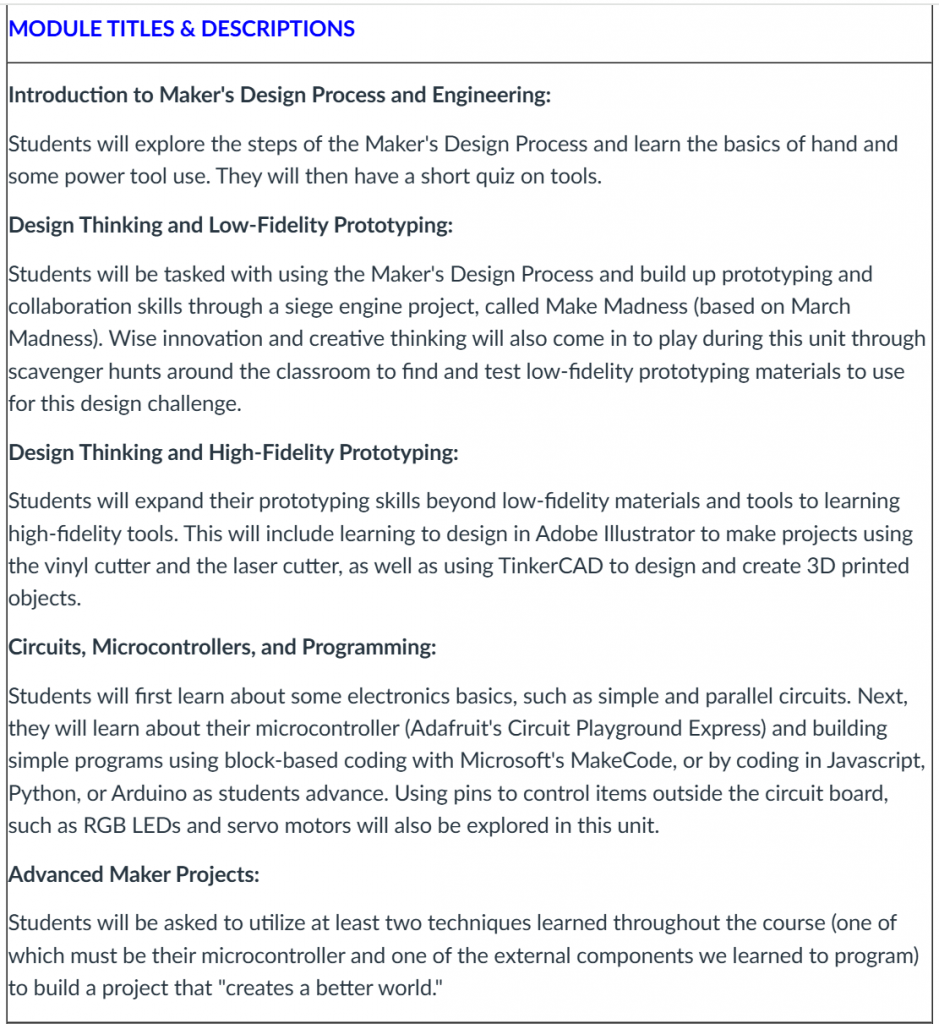
These modules allow students to learn something they might not have the opportunity to learn otherwise, and places a high emphasis on our mission to Innovate Wisely. There is no one “correct” way to complete any of these projects and they are varied both in terms of tools and materials used, as well as what the thing they’re making actually is. I place greater emphasis on teaching the different tools in Illustrator and how to use the program to design what they envision than I do on what the thing they’re making ends up being. This allows for specific feedback on how they used the different design tools in their project from me, as well as immediate feedback from the project itself if it doesn’t look right or function properly. With either feedback, students will know right away if something needs to be changed or improved.
Some examples of feedback given on design assignments are pictured below.
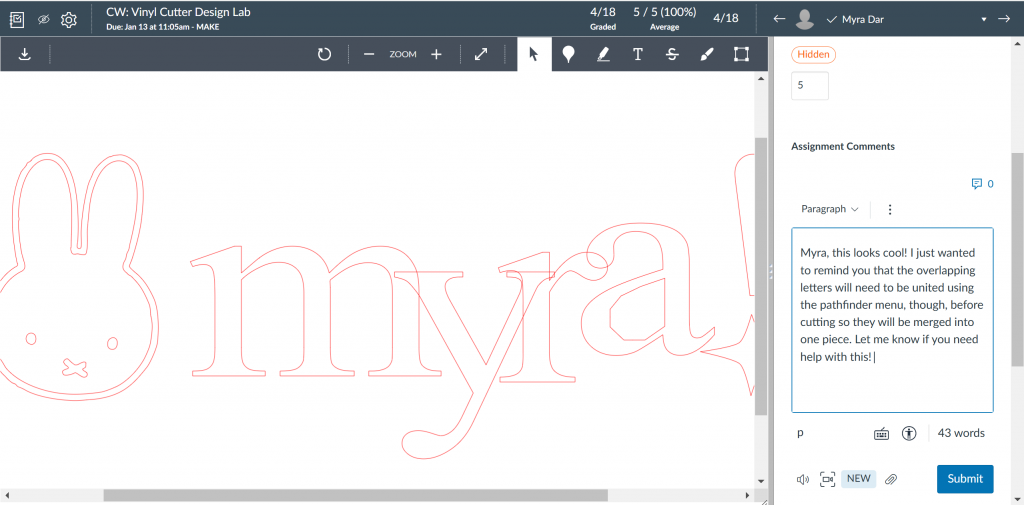
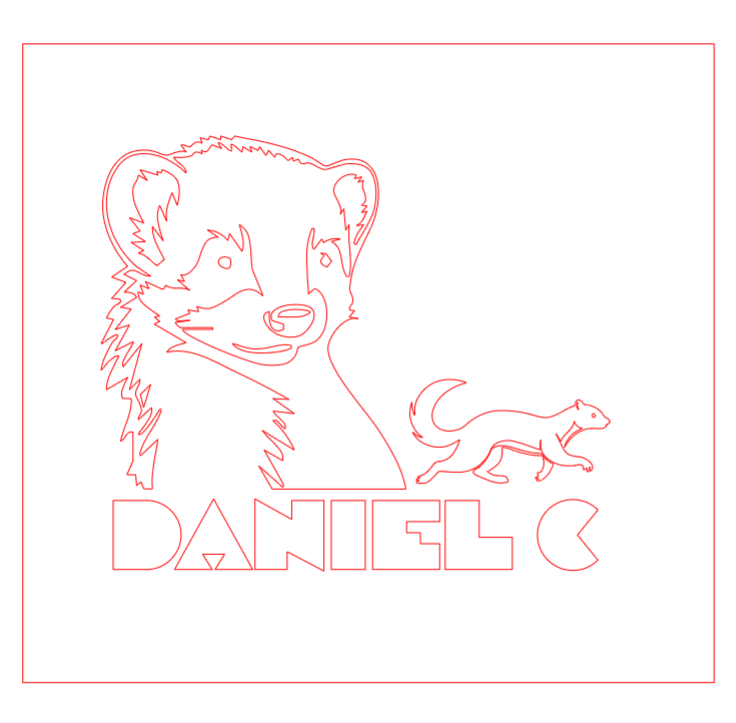
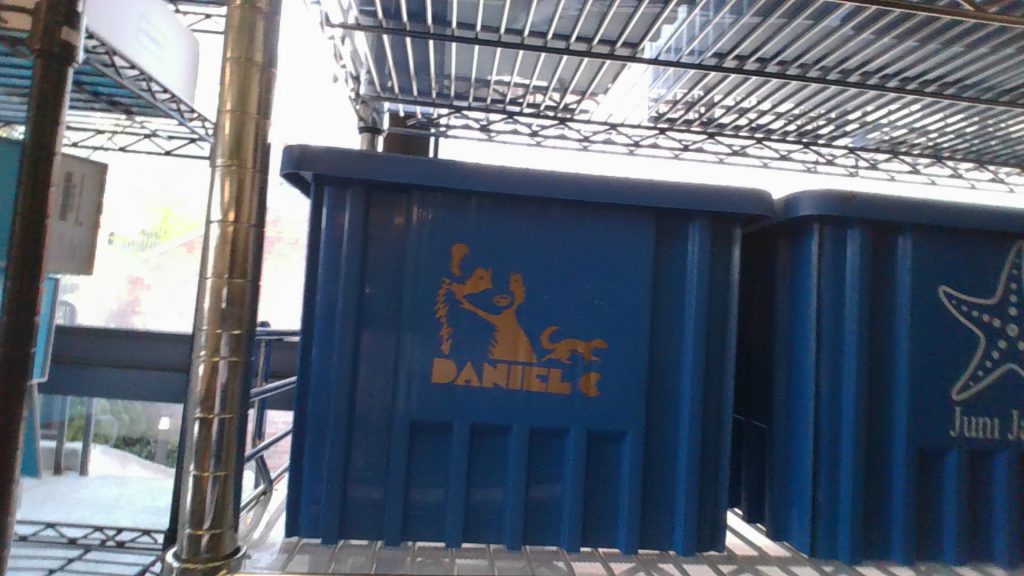
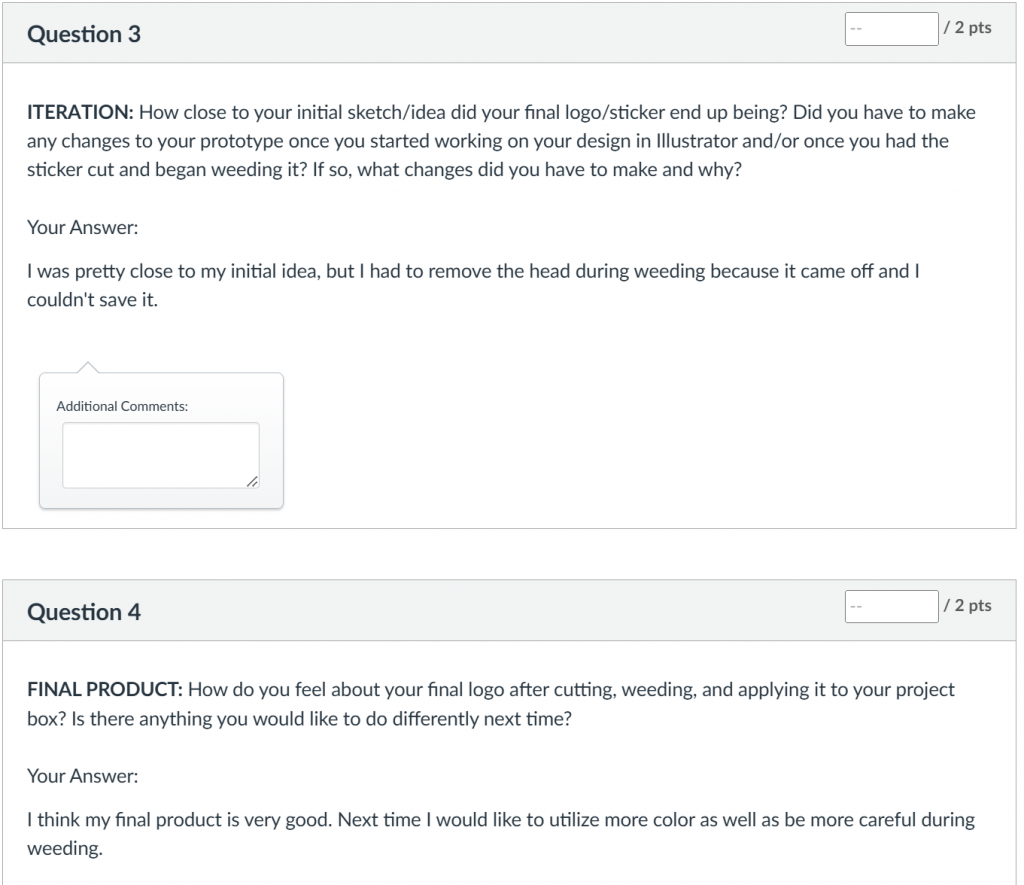
You can also see examples of quality student performance and meaningful teacher feedback in my BOTZ class, that focus on the coding as opposed to the design like the examples above. As we near our culminating activity, SUMO, I assign students the task of programming their line sensor to keep their robot inside of the black line surrounding the SUMO board. As I discussed in Course Design (3), my feedback on student work is given with the Inquiry tenet in mind. I don’t simply look at their program and tell them exactly what is wrong and how to fix it. Instead, I ask guiding questions that push them to look at their code and think about the prompts from my feedback to come up with a plan for something to try. I respond the same whether it’s a written comment in Canvas or in person, much to the chagrin of many students. But this approach pushes them to not only read and think about my feedback and use the resources available to them to try and correct the problem, but results in deeper learning of the concept. You can see in my examples below that both students have a similar issue where their robots are driving forward after sensing the line on the SUMO board, which makes it drive off the board instead of the assigned task which is to stay inside of the line. The day after I gave this feedback in Canvas, I pointed the students towards my Canvas comment and asked them to try something else with their program based on the feedback, without showing them exactly how to fix it. Their approach in responding to my feedback were slightly different. Zelda preferred to make small changes to her program on her own (meaning without using our class resources), load them onto her robot, and test the change on the SUMO board. Kirubel referred to our class OneNote where I had some starter code and guiding questions for them to think about. Both students ended up successfully programming their robots to stay inside the line, despite utilizing different strategies.
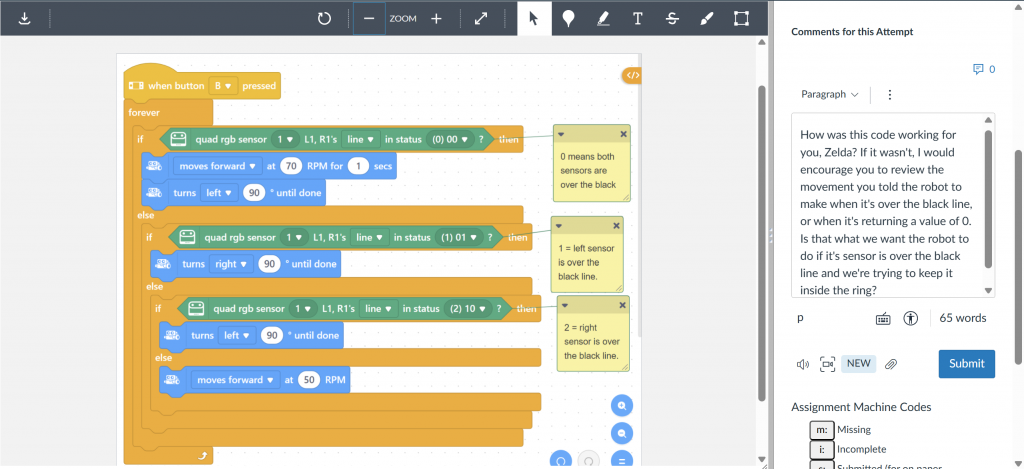
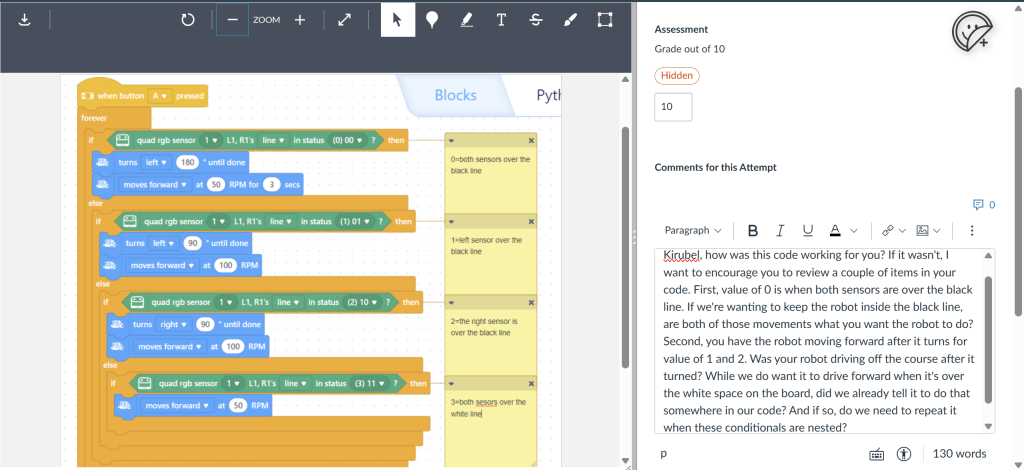
This approach aligns well with our discipline’s current working definition of a competency: Having a collection of knowledge, skills and ways of thinking at your disposal and developing the ability to use the right ones, at the right time, to accomplish your goal. Or put in simpler, MS Student terms: Putting tools in your tool box and knowing how to make something with a combination of those tools.
Designing assignments that foster quality student work and open the door for meaningful feedback is an ongoing, dynamic process—one that evolves as I learn from both student experience and my own reflection. Whether it’s through giving students creative freedom in MAKE or prompting deeper thinking through inquiry-based feedback in BOTZ, my goal is to build a classroom culture where learning is active, personalized, and rooted in problem-solving. By offering opportunities for experimentation, iteration, and reflection, I aim to help students build confidence in their abilities, learn how to apply their skills in thoughtful ways, and ultimately see themselves as capable makers and thinkers.
(2) Designs major assessments that reflect course outcomes
My practice of designing major assessments has shifted dramatically in my time at EPS. I originally taught Science and Math, which are courses for which quizzes and tests are well-suited and easy to build. However, once I started teaching robotics, engineering, and web design, I discovered these courses don’t always lend themselves easily to the traditional assessment methods of tests and quizzes. Recognizing this, I’ve designed major assessments in my tech classes to be project-based, allowing students to apply what they’ve learned throughout the course in practical, hands-on ways. These assessments are intentionally structured to evaluate student understanding within the context of class activities, providing meaningful opportunities for them to demonstrate their learning through real-world application. The course work in my classes also typically provide an immediate feedback loop for students: their robot doesn’t move through the maze correctly, the inner parts of o’s and e’s fall out of their laser cut project because they weren’t connected to anything, or images don’t load on a website. As such, the major assessments I build into my courses are projects for which the main requirement is that their code and their designs function properly and look nice. My assessments are typically centered around those feedback loops and the application of course content in hands-on projects.
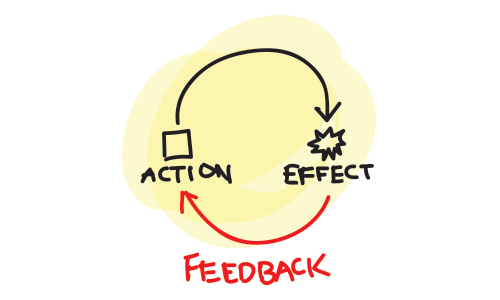
In BOTZ, the primary goal of the course is that they learn basic programming concepts, such as loops and conditionals, learn to use hand tools to customize and build their robots, and learn to use and program sensors to accomplish specific tasks with their robots. We have two major assessments in this course: Balloon Battle and SUMO. For Balloon Battle, they attach balloons to the back of their robots and a popping device to the front, then program their Ultrasonic Sensor to seek out their opponents balloons with the goal of popping them. For SUMO, they compete in a “wrestling” competition with their robots, the goal being to stay inside of the ring and to push their opponent out of it. They have to combine their practice of programming the Ultrasonic Sensor to find their opponent, and the Line Following sensor to see where the line at the edge of the course is and respond by backing away from that line to keep themselves inside of it.
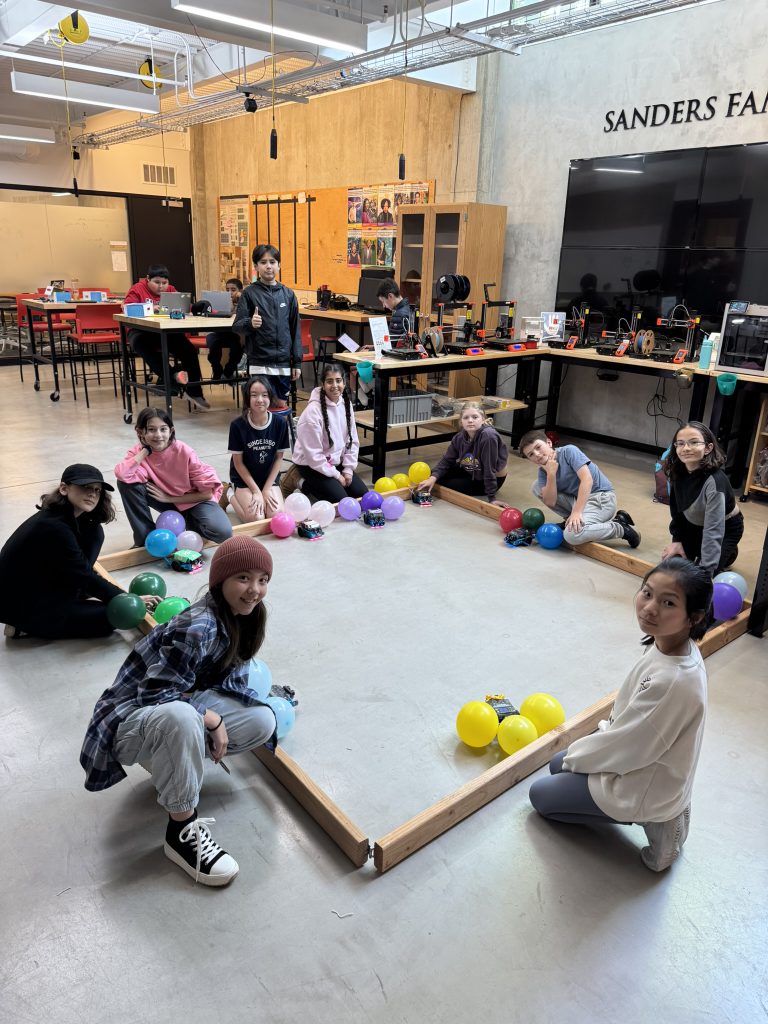
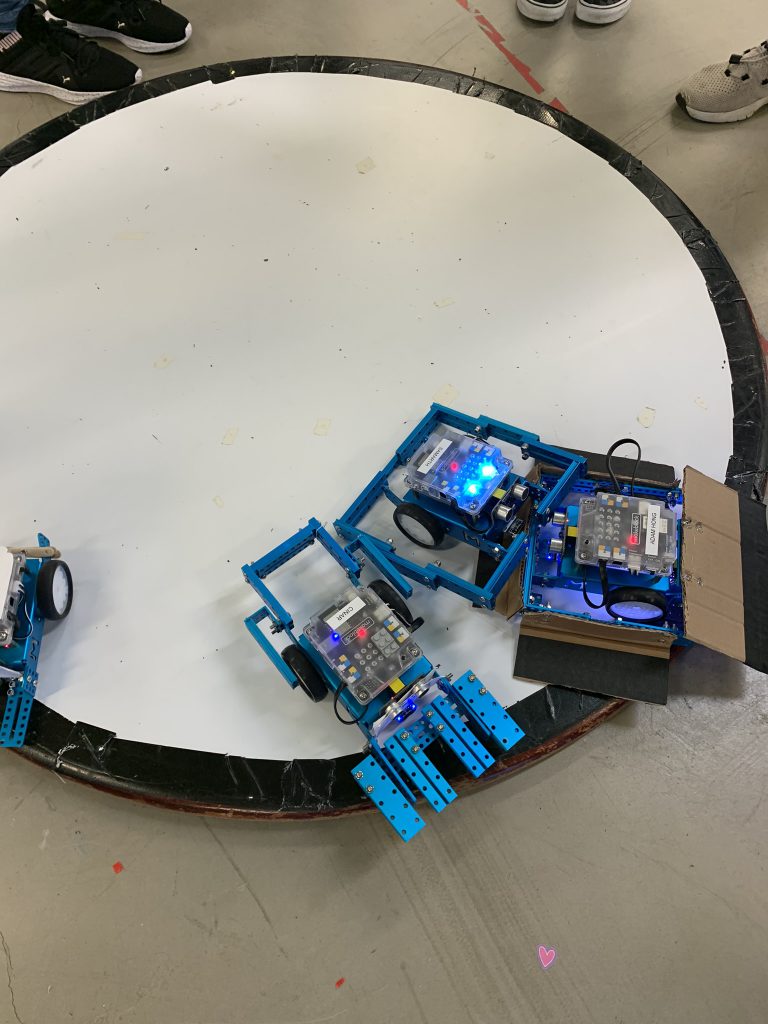
Both of these games require students to apply their knowledge of conditionals (if/then/else), as well as how to nest them (Else/If or elif in Python), to ensure the sensors are working and communicating with each other to perform the essential tasks of the games. Additionally, they need to think of and build attachments or features of their robots to help with offensive or defensive movements, such as 3D printing a bulldozer to lift the wheels of their opponent’s robot off the course or painting popsicle sticks black and attaching them to the bottom of their robot to confuse their opponents about where the black line is. Their work on these major assessments includes their program, so I can see that they’ve used nested conditionals, forever loops, and the sensor data correctly, a photo of their robot, so I can see what customization they did and if they used solid engineering, and a reflection of how they performed in the games along with a discussion which changes they would make to their program or their robot build if we were to continue the game.
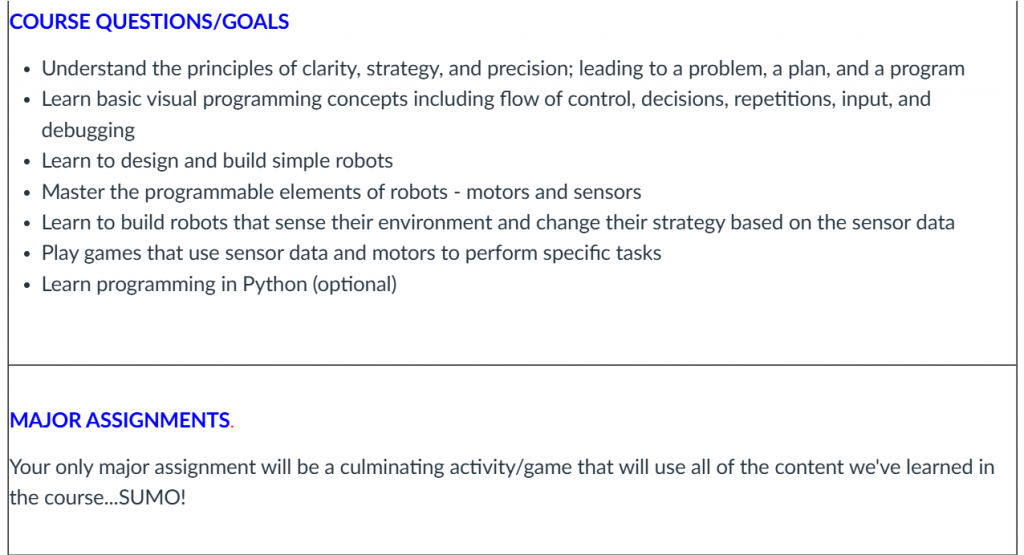
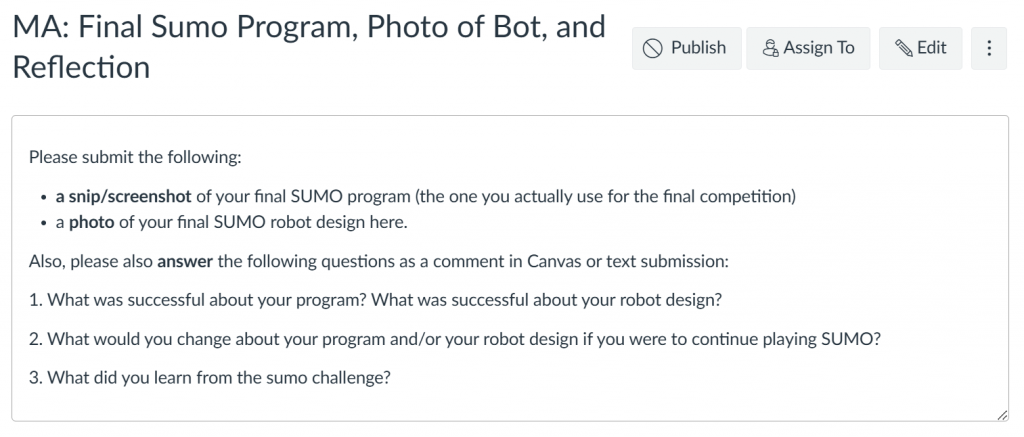
For MAKE, students are tasked with applying the content learned throughout the course, as well as our school’s vision statement, to create a project with the aim of solving a problem that would “Create a Better World.” Throughout the course, students learn basic principles of design, iteration, and prototyping used in engineering. They learn how to use both low and high-fidelity tools to create their projects as well as basic circuitry designed to continue their journey through programming concepts by working with a Circuit Playground Express microcontroller. The culminating assessment is for students to identify a problem facing our world today, then build a prototype of a product that could solve that problem and “Create a Better World” using at least two different techniques they learned during the trimester. You can read more about this project in Course Design (1).
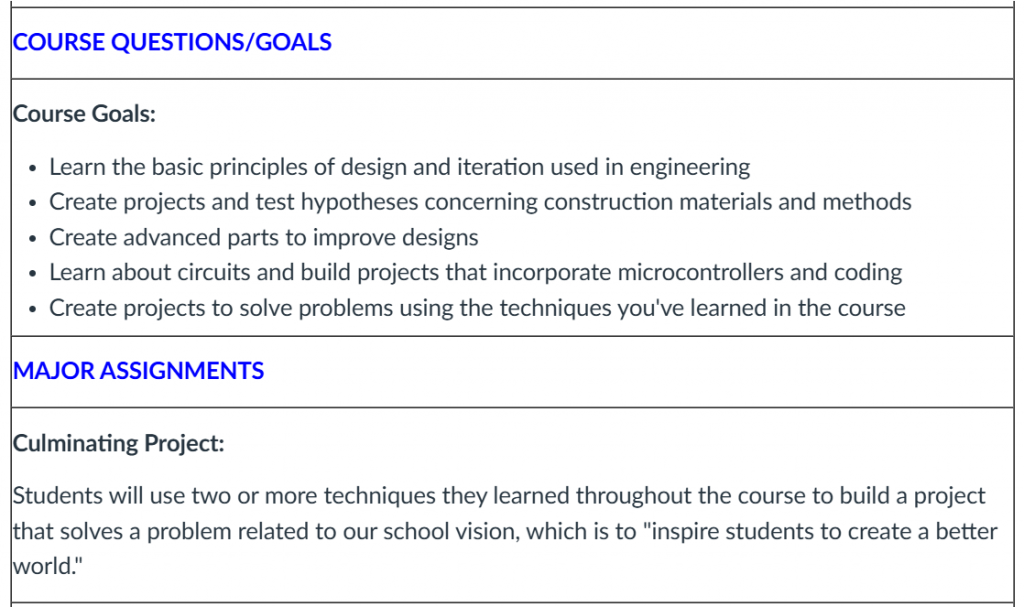
For WEB, we do hands-on project-based assessments still, but in a different manner than in BOTZ and MAKE. We swap the creation of physical objects for digital, and move beyond block coding to learn text coding (HTML, CSS, and JS). The other difference in this class compared to BOTZ and MAKE is earning a letter grade in this class, instead of pass or not pass. This makes assessments higher-stakes for 8th graders, so while I do have them complete website projects to check that they understand the coding languages I’ve taught them in the course, we also have a quiz over the Internet and Networks research we complete at the start of the trimester. This school year, I beefed up this quiz with more questions and added content from the research they do on the Internet and Networks, but also questions from the Blown to Bits reading. The goal of changing the quiz was not only to include a broader selection of material we cover, but also to construct an assessment that gave me better feedback on the depth of understanding each student had from the first unit.
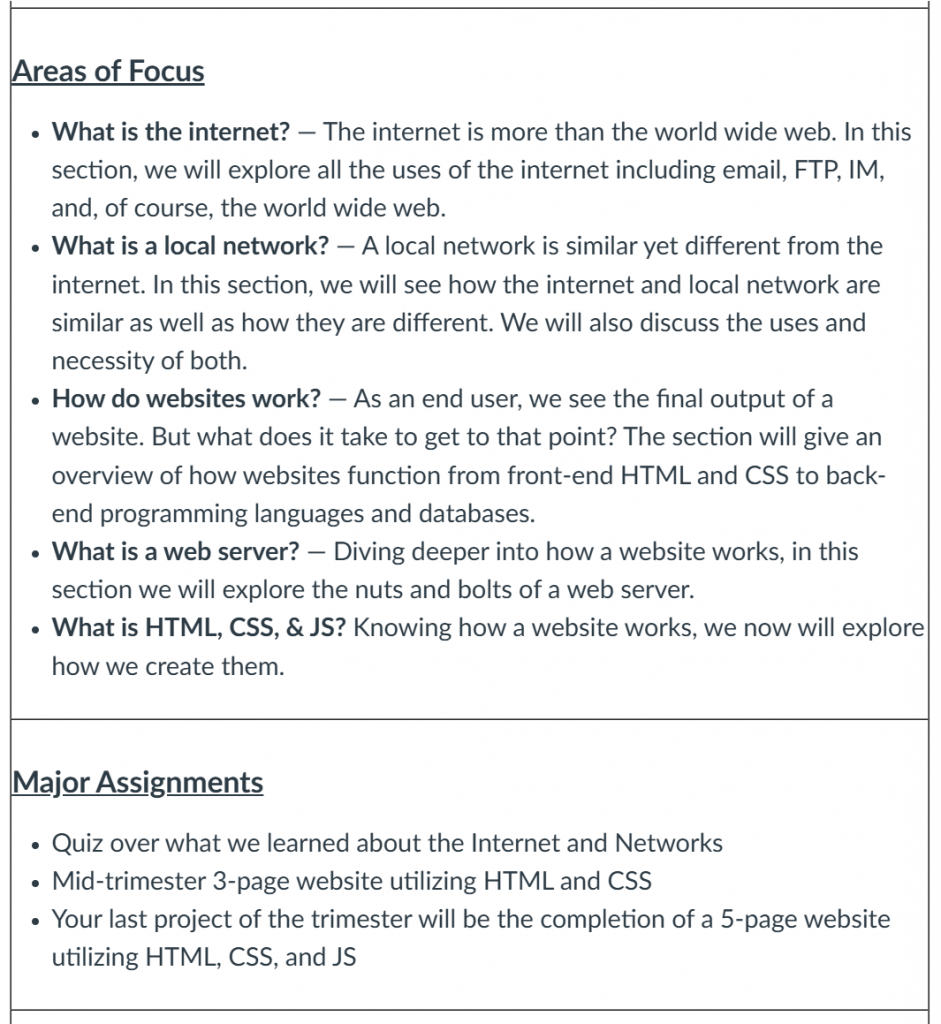
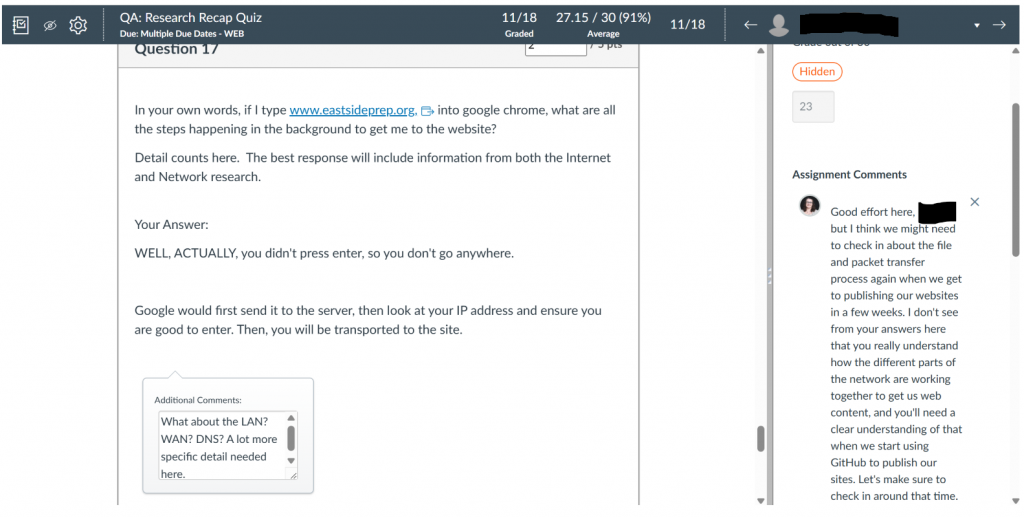
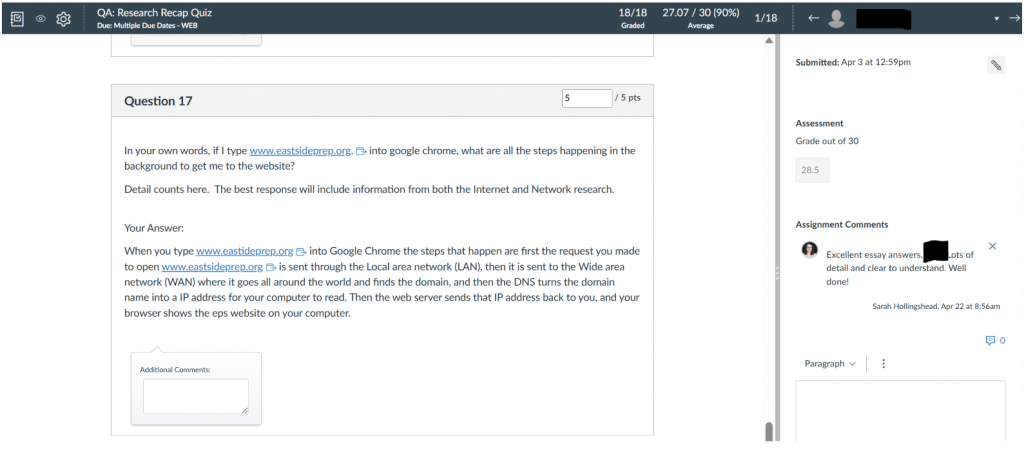
Beyond this single quiz, students are tasked at the end of the course with building a 5-page website that incorporates the three languages we learned: HTML, CSS, and JS. In addition to assessing their understanding of the coding languages, I also assess their understanding of proper folder setup and file naming, as this is the first time I won’t walk them through this process. Proper folder and file setup and naming is crucial to the website will functioning properly when we load it onto the web server making it a live site, so I want to assess their ability to do this independently. Finally, I have students build a portfolio of their WEB projects in GitHub. This not only makes all of their projects live sites on the Internet that they can send to family and friends, but also shows their skill progression throughout the course. Once their projects are live, we also check every project to find and fix any errors that show up after they’re loaded onto the web server, as some errors are not visible until after this process has been completed. This process also ties in their research on Networks from the start of the trimester, as we discussed File Transfer and the roles of DNS and Web Servers in a Network.
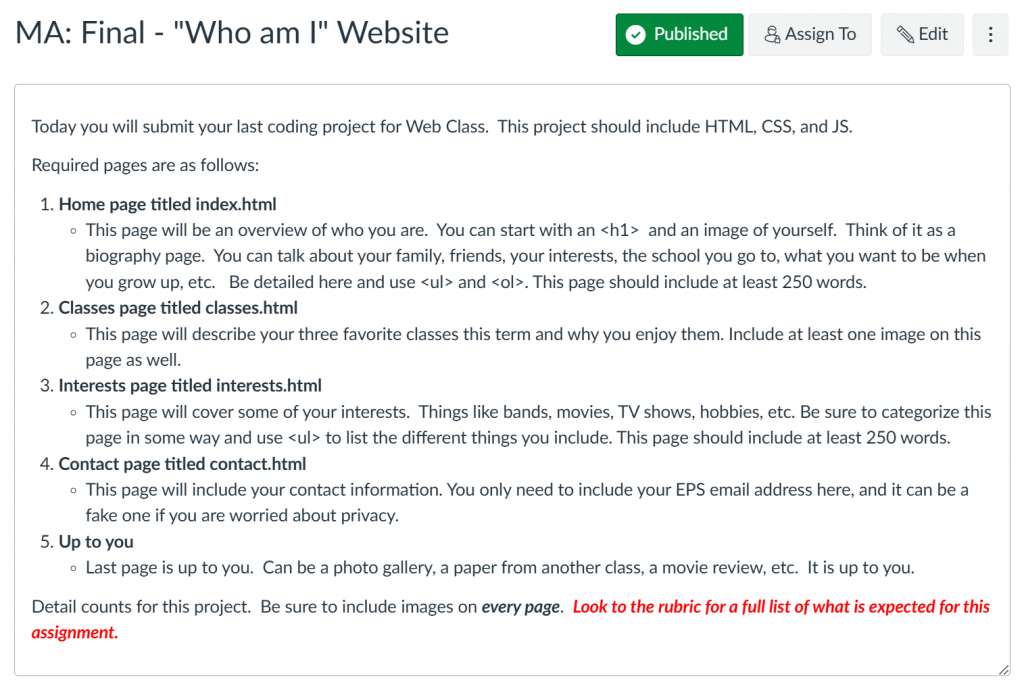
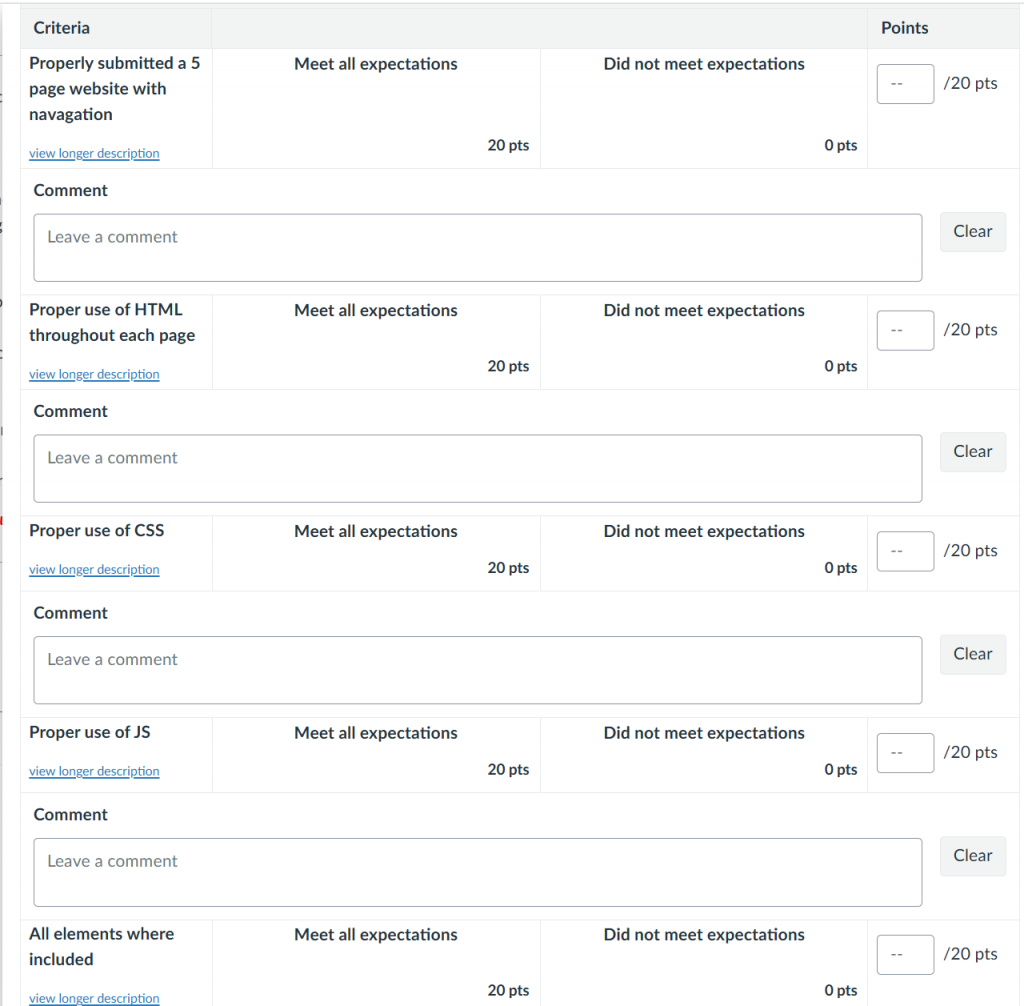
You can view a couple of stellar student projects for this assignment at the links below:
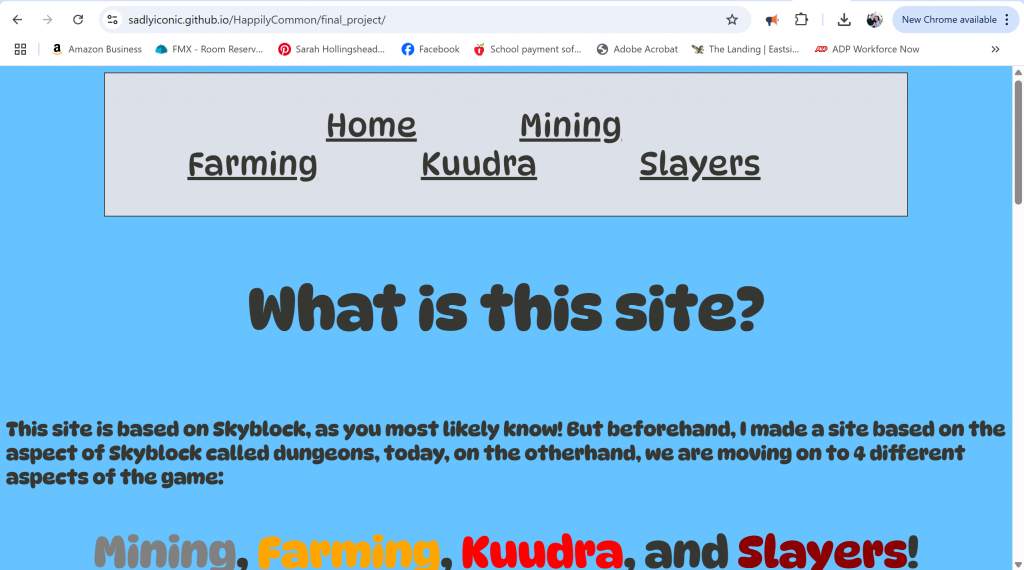
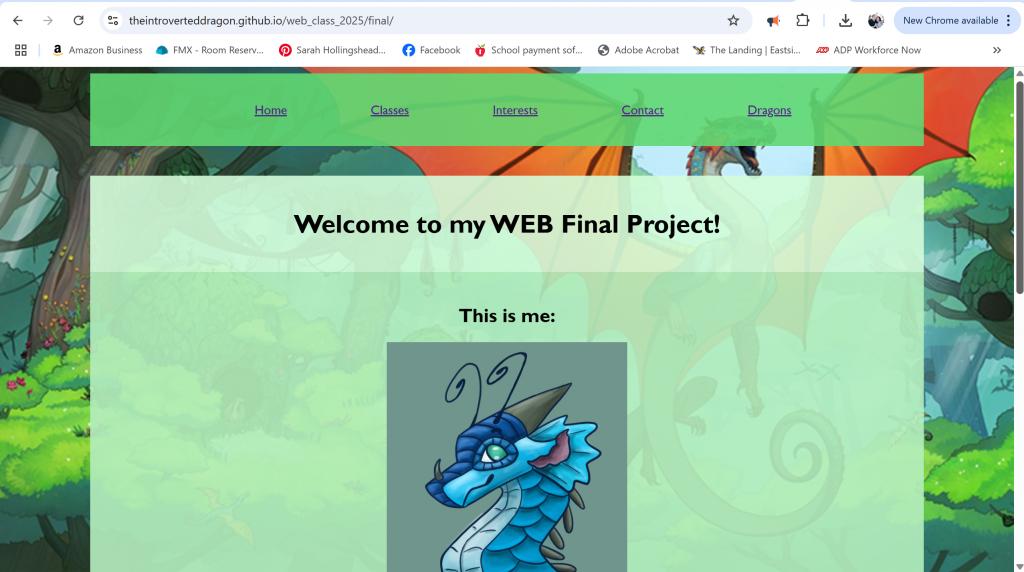
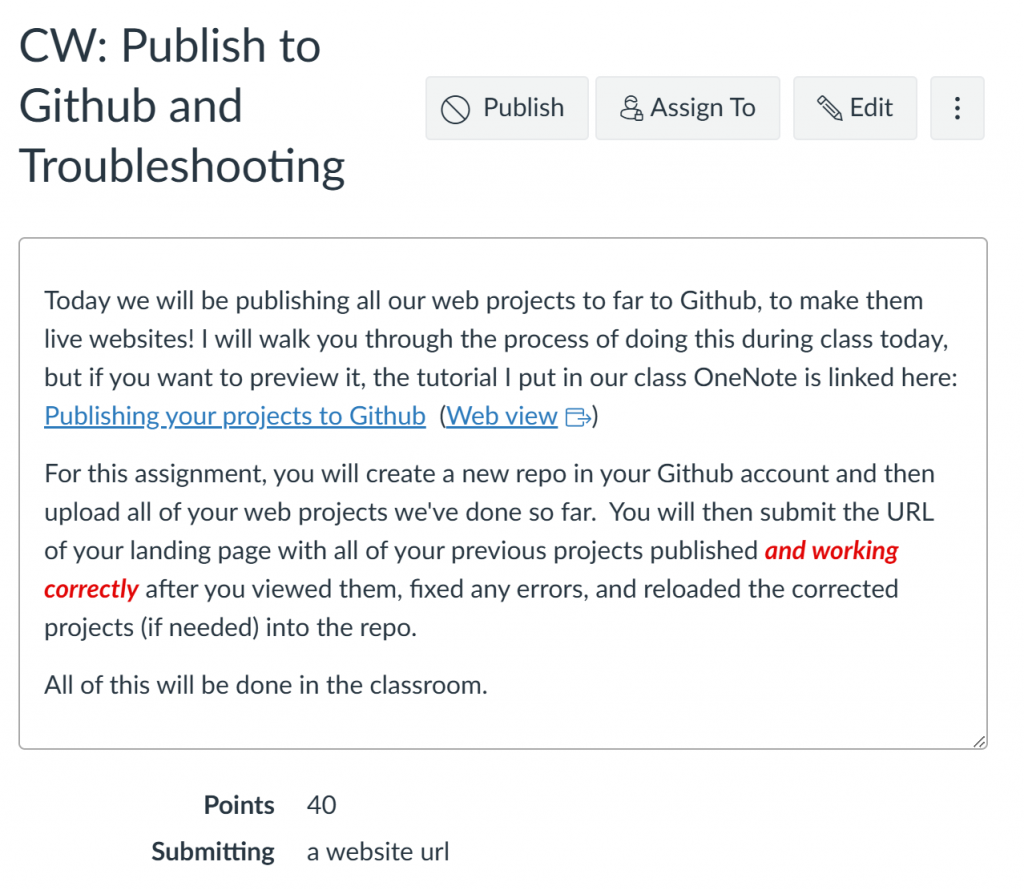
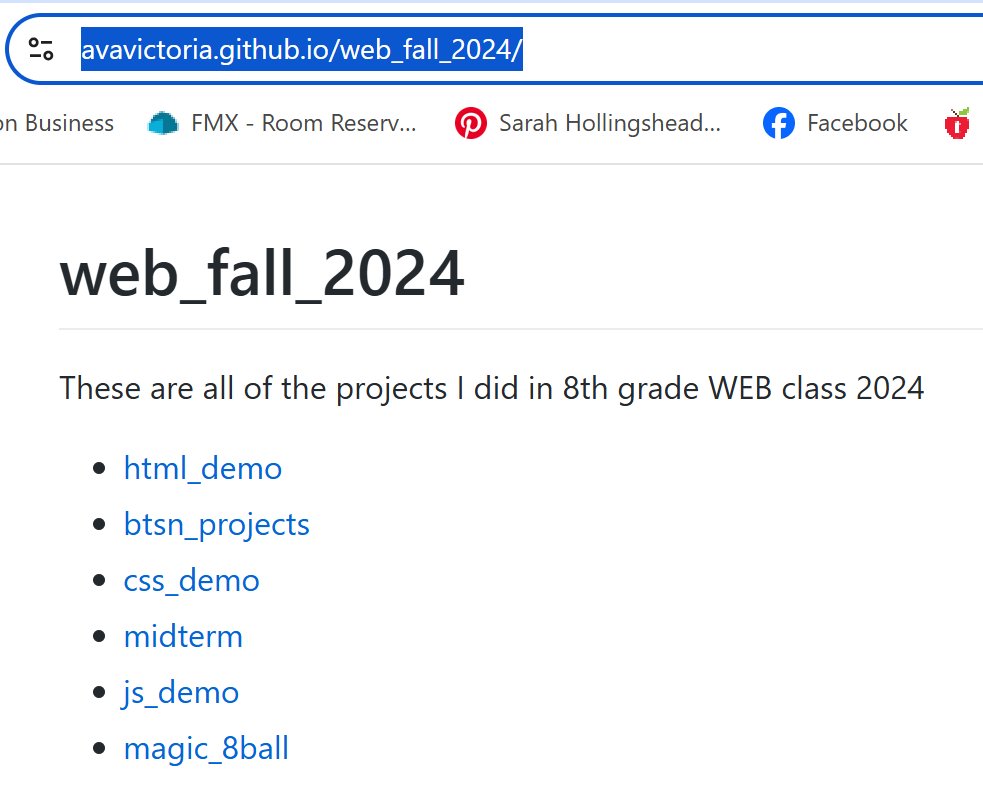
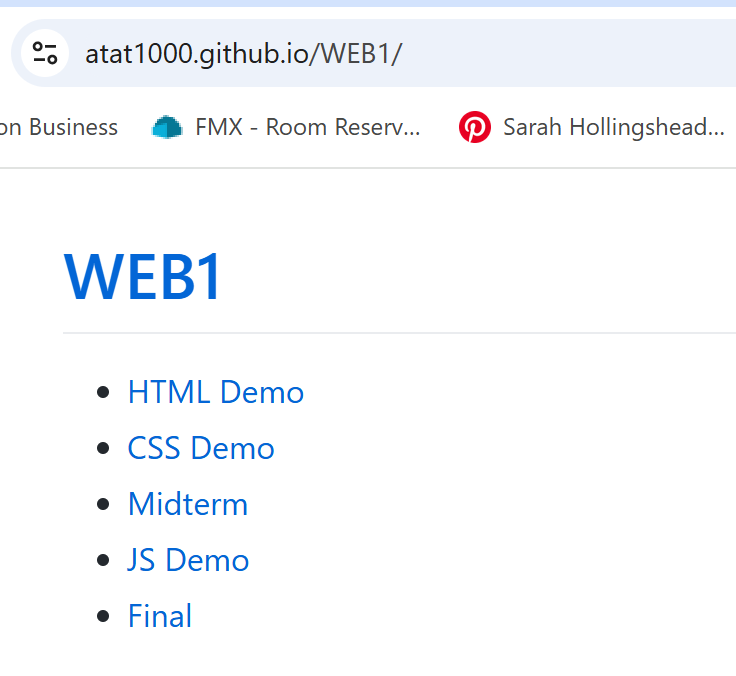
https://atat1000.github.io/WEB1/
Across all three of my technology courses—BOTZ, MAKE, and WEB—major assessments are intentionally designed to reflect and reinforce the core outcomes of each course. Rather than relying on traditional tests and quizzes, I center my assessments on real-world, project-based experiences that give students the opportunity to apply their learning in tangible and meaningful ways. In BOTZ, the culminating SUMO and Balloon Battle challenges synthesize programming, problem-solving, and engineering design—key learning goals of the course. MAKE tasks students with identifying real-world problems and building functional prototypes, aligning with both course content and our school’s mission to “Create a Better World.” In WEB, assessments combine technical knowledge with creativity, as students demonstrate mastery of HTML, CSS, and JavaScript through multi-page websites and GitHub portfolios, while also integrating early-unit learning on Internet infrastructure. These assessments reflect the outcomes I want for students: to think critically, use the right tools at the right time, and create solutions that work—whether physical or digital. Ultimately, the assessments I design are not only measures of student achievement but also extensions of the learning process itself, providing meaningful opportunities for feedback, iteration, and growth.